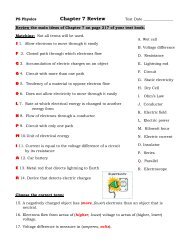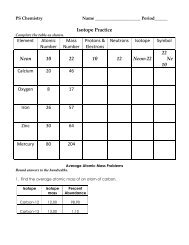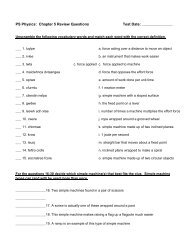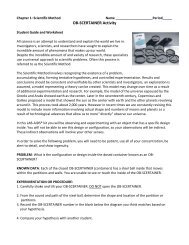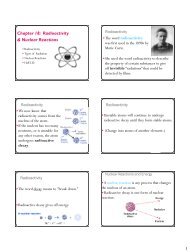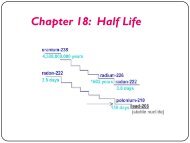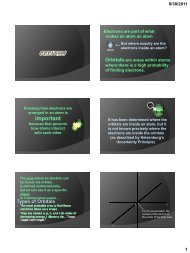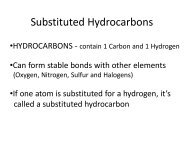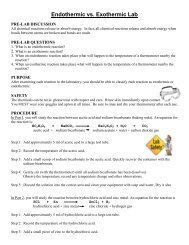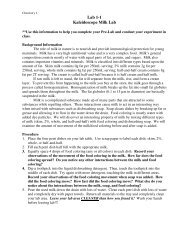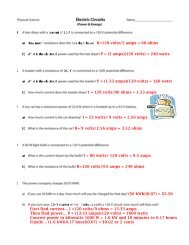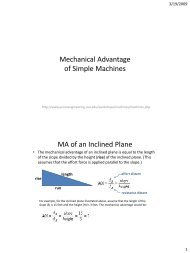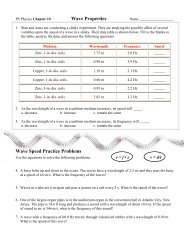Create successful ePaper yourself
Turn your PDF publications into a flip-book with our unique Google optimized e-Paper software.
<strong>PS</strong> <strong>Physics</strong> <strong>Sound</strong> <strong>Stations</strong> <strong>Lab</strong> <strong>Activity</strong><br />
Objectives<br />
Compare sounds created by different objects and mediums;<br />
Determine sound intensity and duration in different mediums.<br />
Names(s)_________________<br />
Materials<br />
Station 1<br />
3 wine glasses with various amounts of water<br />
Station 2<br />
various size tuning forks<br />
stop watch<br />
rubber mallet<br />
2 large beakers filled with water<br />
Station 3<br />
2 cups with strings between them 2 space phones<br />
Station 4<br />
8 jars with different amounts of water<br />
something to strike jars with<br />
Station 5<br />
2 whirling sound tubes<br />
Station 6<br />
Boomwhackers set<br />
rubber mallet<br />
tuning forks (288 Hz, 320 Hz, 341.3 Hz, 384 Hz, 426.7 Hz, 480 Hz)<br />
Procedure<br />
PLEASE FOLLOW THE DIRECTIONS CAREFULLY STEP BY STEP<br />
Singing Glasses-<strong>Activity</strong> station #1<br />
1. Hold the bottom of a partially filled wine glass with one hand. Wet the top rim of the glass and run<br />
your finger around the edge quickly.<br />
2. Answer question #1.<br />
3. Choose two glasses with different amounts of water in them and repeat the procedure. PLEASE<br />
HOLD THE BOTTOM OF THE GLASS!<br />
4. Answer question #2 and question #3.<br />
5. If time permits try to set up a musical scale.<br />
6. Mix glasses up before you leave the station.<br />
Tuning Fork-<strong>Activity</strong> Station #2<br />
1. Strike the prongs of the large tuning fork sharply with a rubber mallet. Observe the loudness of the<br />
sound and use the stopwatch to measure the length of time it can be heard before it "dies away."<br />
2. Answer questions #1 and #2 on activity sheet.<br />
3. Strike the same fork again. This time hold the rod end firmly against a tabletop. Observe the<br />
loudness of the sound and use the stopwatch to measure the length of time it can be heard.<br />
4. Answer questions #3 and #4 on the activity sheet.
5. Strike the large tuning fork sharply against a large rubber stopper. Put the tuning fork into water<br />
and observe what happens.<br />
6. Do the above procedure again using the smaller tuning fork and observe what happens.<br />
7. Answer question #5 on the activity sheet. If you need to repeat the process to answer the question<br />
please do so.<br />
8. Please dry tuning fork thoroughly.<br />
"Telephone" <strong>Sound</strong>-<strong>Activity</strong> Station #3<br />
1. One person should hold a cup to their ear and the other partner should talk into the other cup.<br />
Make sure the string is tight but do not pull the string out of the cups!<br />
2. Answer questions #1-#3 on the activity sheet.<br />
3. Use the special Space Phone as you did the cups.<br />
<strong>Sound</strong> Bottles-<strong>Activity</strong> station #4<br />
1. Answer question #1 on the activity sheet.<br />
2. Gently strike the side of the bottle with the metal spoon.<br />
3. Answer question #2.<br />
4. Experiment with where you strike the bottle. Answer question #3.<br />
5. Strike the bottles carefully noting which bottle has the highest pitch and which has the lowest.<br />
6. Answer questions #4 and #5.<br />
<strong>Sound</strong> Tubes-<strong>Activity</strong> station #65<br />
1. Take sound tube and slowly twirl it above your head.<br />
2. Answer question #1.<br />
3. Increase the speed of the tube.<br />
4. Answer question #2.<br />
5. Change the direction you spin the tube.<br />
6. Answer question #3.<br />
7. Change the end of the tube you are holding (hold the other end) and do all of the above steps again.<br />
8. Answer question #4.<br />
9. Choose the end of the tube to hold that worked the best and try lifting the tube up and down when<br />
you spin it.<br />
10. Answer question #5.<br />
11. Go to station #7 when told to do so, you will be sharing this station with another group.<br />
Boomwhackers-<strong>Activity</strong> station #6<br />
1. Remove all black caps from the ends of the Boomwhackers.<br />
2. Whack two different tubes against your upper leg.<br />
3. Answer question #1.<br />
4. Repeat step 2, comparing tubes of different lengths.<br />
5. Answer question #2.<br />
6. Cap one end of a tube and whack again.<br />
7. Answer question #3.<br />
8. Strike a 288 Hz tuning fork and hold it just on the inside end of the tube marked D.
9. Answer question #4.<br />
10. Strike the following tuning forks and hold each one just on the inside of the corresponding tube.<br />
Tube (scale)<br />
D<br />
E<br />
F<br />
G<br />
A<br />
B<br />
Tuning Fork Frequency<br />
288 Hertz<br />
320 Hertz<br />
341. 3 Hertz<br />
384 Hertz<br />
426.7 Hertz<br />
480 Hertz<br />
Assessment<br />
<strong>Activity</strong> Station #1<br />
1. What type of sound did you produce? What did it sound like?<br />
2. Which glass had the highest pitch sound? Did it have more or less water?<br />
3. What do you believe caused the sound, the water, the air, or the glass?<br />
4. Were you able to set up a musical scale? If so, how did the amount of water and pitch compare?<br />
<strong>Activity</strong> Station #2<br />
1. What was the relative loudness of the tuning fork, was it loud or could you barely hear it?<br />
2. Using the stopwatch, how long does it take for the sound to die out so you can no longer hear the<br />
tuning fork?<br />
3. What is the relative loudness now, was it loud or could you barely hear it?<br />
4. Using the stopwatch, how long does it take for the sound to die out so you can no longer hear the<br />
tuning fork?<br />
5. Which tuning fork spilled the most water? WHY?!<br />
<strong>Activity</strong> Station #3<br />
1. How is sound transferred from one cup to the other?<br />
2. What is the medium that it is being transferred in?
3. <strong>Sound</strong> waves are what type of wave?<br />
4. Why did the sound transmit better with the special "telephone?"<br />
<strong>Activity</strong> Station #4<br />
1. What will happen if you strike the bottle with a metal spoon?<br />
2. What vibrated to make the sound you heard?<br />
3. Where did you hit the jar to give the best sound?<br />
4. Write a hypothesis concerning which bottle will have a higher pitch and which will have a lower pitch.<br />
5. Was your hypothesis correct? Which bottle had the highest and which had the lowest?<br />
<strong>Activity</strong> Station #5<br />
1. What did it sound like? What type of sound did it make?<br />
2. Did the sound change when you increased the speed? What did it sound like?<br />
3. Did changing the direction change the sound?<br />
4. Did changing the direction of the tube change the sound?<br />
5. Write a statement explaining how best to get sound from the tubes.<br />
<strong>Activity</strong> Station #6<br />
1. Which tube produced a lower tone (longer or shorter of the two tubes)?<br />
2. Why do you think the longer tubes produced lower tones?<br />
3. How does the tone of the caped tube compare to the open tube?’<br />
4. The tube resonates with the tuning fork, what does that tell you about the frequency of the tube?



